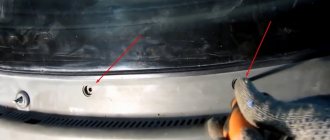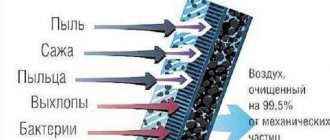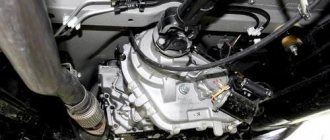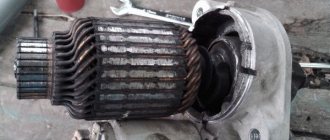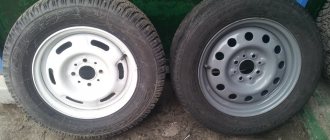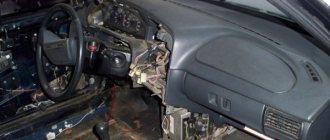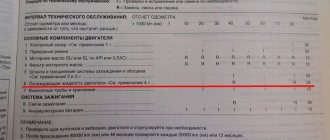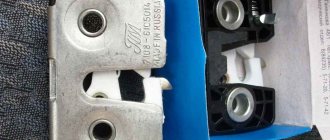| This article lacks links to sources of information. Information must be verifiable, otherwise it may be questioned and deleted. You may edit this article to include links to authoritative sources. This mark was set on October 1, 2013 . |
LADA Samara
LADA Samara on Wikimedia Commons
Total information
| Manufacturer | AvtoVAZ |
| Years of production | 1997—2012 |
| Assembly | AvtoVAZ (Tolyatti, Russia) |
| Class | Small 2 groups |
| Other designations | Lada Samara - 2, “tag” |
Design
| Body type(s) | 4-door sedan (5-seater) |
| Layout | front engine, front wheel drive |
| Wheel formula | 4 × 2 |
Engines
VAZ-2111
| Manufacturer: | Volzhsky Automobile Plant |
| Brand: | VAZ-2111 |
| Type: | petrol |
| Volume: | 1499 cm3 |
| Maximum power: | 56.5 kW (77 hp), at 5400 rpm |
| Maximum torque: | 115.7 Nm, at 3000 rpm |
| Configuration: | in-line, 4-cylinder. |
| Cylinders: | 4 |
| Valves: | 8 |
| Max. speed: | 158 km/h |
| Acceleration to 100 km/h: | 13.2 s |
| Fuel consumption combined cycle: | 7.8 l/100 km |
| Fuel consumption in the urban cycle: | 8.9 l/100 km |
| Fuel consumption on the highway: | 5.7 l/100 km |
| Environmental standards: | EURO-2 |
| Cylinder diameter: | 82 mm |
| Piston stroke: | 71 mm |
| Compression ratio: | 9,8 |
| Supply system: | Distributed injection |
| Clock (number of clock cycles): | 4 |
| Cylinder operating order: | 1-3-4-2 |
| Recommended fuel: | AI-95 or AI-92 |
VAZ-21114
| Manufacturer: | Volzhsky Automobile Plant |
| Brand: | VAZ-21114 |
| Type: | petrol |
| Volume: | 1596 cm3 |
| Maximum power: | 60 kW (82 hp), at 5200 rpm |
| Maximum torque: | 125 Nm, at 3000 rpm |
| Configuration: | in-line, 4-cylinder. |
| Cylinders: | 4 |
| Valves: | 8 |
| Max. speed: | 160 km/h |
| Acceleration to 100 km/h: | 13 s |
| Fuel consumption combined cycle: | 7.6 l/100 km |
| Fuel consumption in the urban cycle: | 8.8 l/100 km |
| Fuel consumption on the highway: | 5.3 l/100 km |
| Environmental standards: | EURO-2 |
| Cylinder diameter: | 82 mm |
| Piston stroke: | 75.6 mm |
| Compression ratio: | 9,6 |
| Supply system: | Distributed injection |
| Clock (number of clock cycles): | 4 |
| Cylinder operating order: | 1-3-4-2 |
| Recommended fuel: | AI-95 or AI-92 |
VAZ-11183
| Manufacturer: | Volzhsky Automobile Plant |
| Brand: | VAZ-11183 |
| Type: | petrol |
| Volume: | 1596 cm3 |
| Maximum power: | 60 kW (82 hp), at 5200 rpm |
| Maximum torque: | 120 Nm, at 2500-2700 rpm |
| Configuration: | in-line, 4-cylinder. |
| Cylinders: | 4 |
| Valves: | 8 |
| Max. speed: | 160 km/h |
| Acceleration to 100 km/h: | 13 s |
| Fuel consumption combined cycle: | 7.6 l/100 km |
| Fuel consumption in the urban cycle: | 8.8 l/100 km |
| Fuel consumption on the highway: | 5.3 l/100 km |
| Environmental standards: | EURO-3 |
| Cylinder diameter: | 82 mm |
| Piston stroke: | 75.6 mm |
| Compression ratio: | 9,6-10 |
| Supply system: | Distributed injection |
| Clock (number of clock cycles): | 4 |
| Cylinder operating order: | 1-3-4-2 |
| Recommended fuel: | AI-95 |
Transmission
| 5-speed | |
| Number of steps: | 5 |
| Gear ratios: | |
| 1st gear: | 3,636 |
| 2nd gear: | 1,950 |
| 3rd gear: | 1,357 |
| 4th gear: | 0,941 |
| 5th gear: | 0,784 |
| Reverse gear: | 3,530 |
| Switching: | floor lever |
Characteristics
Mass-dimensional
| Length | 4330 mm |
| Width | 1650 mm |
| Height | 1402 mm |
| Clearance | 165 mm |
| Wheelbase | 2460 mm |
| Rear track | 1370 mm |
| Front track | 1400 mm |
| Weight | 1000 kg |
On the market
| Predecessor Predecessor VAZ-21099 |
| Related | VAZ-2113 VAZ-2114 |
| Segment | B-segment |
Other
| Load capacity | 425 kg |
| Volume of the tank | 43 l |
Modifications
Lada-2115-20, Lada-2115-40
VAZ-2115 (LADA Samara)
- a subcompact front-wheel drive car with a sedan body, developed by the Volzhsky Automobile Plant. The car is part of the LADA Samara family.
Story
| This article may contain original research. Add links to sources, otherwise it may be set for deletion. More information may be on the talk page. (July 24, 2016) |
VAZ-2115 became the first-born of the line codenamed “Samara-2”, after the Sputnik/Samara family, which became the most modified model of this family. This fact of modernization is confirmed by the fact that the VAZ-2115 has significantly changed the rear part of the car body. Namely the trunk lid, lighting devices. No similar transformations followed on the VAZ-2113 and VAZ-2114 cars. VAZ-2115 is a restyled model of VAZ-21099. The new model differed from its predecessor in the rounded shape of the hood and front fenders, trunk lid, new front and rear optics, bumpers painted in body color, trunk spoiler with an additional brake light, door sill fairings, door moldings, as well as a new interior and upgraded electrical equipment.
Initially, plans to modernize the Samara-2 line included changing not only the exterior of the body and trim, but also improving the suspension, transmission and braking system. However, ultimately, all these nodes were borrowed from the Samara-1 family without any significant changes. This made it possible to achieve a high degree of unification with the “ninth” family. The car received a more streamlined shape, thanks to which the angular outlines of the exterior, characteristic of the first generation Samar, are a thing of the past. Loading things into the trunk became much more convenient - now the loading height was at the level of the bumper. And a more advanced injection engine made it possible to develop more power, consume less fuel and warm up faster. In addition, the electronic engine control system monitored the level of exhaust toxicity.
Electrical equipment has also been improved. Now the car package included: electric windows for the front doors, as well as fog lights and heated seats (only on “luxury” versions). All versions were equipped with an on-board monitoring system, which made it possible to monitor the proper operation of lamps, oil level, brake pad wear, and the level of coolant and washer fluids directly from the driver’s seat.
Pilot modifications of the VAZ-2115 (from 1997 to 2000) were equipped with VAZ-21083 carburetor engines with a displacement of 1499 cm³ and a power of 71.6 liters. With. and the “high panel” from Samara-1. Since 2000, when the car was launched into mass production, they began to install the then new VAZ-2111 engines with distributed fuel injection, a displacement of 1499 cm³ and a power of 77.8 hp. With. And since 2007, the VAZ-2111 engine was replaced by a newer, improved, injection engine VAZ-11183, with a displacement increased to 1596 cm³ and a power of 80.9 liters. With.
At first, the “related” cars VAZ-21099 and VAZ-2115 were produced at the plant in parallel, until in 2004 the “fifteenth” model completely replaced the VAZ-21099.
In 2007, the bumpers and side moldings began to be painted completely in color (without the gray stripe).
In 2008, the VAZ-2115 underwent cosmetic changes in its appearance in order to better meet the criteria of modern automotive fashion. So, for example, the old wide molding on the car doors, painted gray from the factory, gave way to new, narrow moldings in body color (popularly called “euro-molding”), which nevertheless did not look very harmonious, given the unchanged design bumpers.
The VAZ-2115 was discontinued in December 2012 due to the appearance on the market of a newer, modern and safer Lada Granta sedan[1].
Button control
It is very convenient when control (opening the trunk) is carried out from a button. Every car owner knows that it is very important to ensure that the trunk, like the car doors, closes securely. Reliable operation of trunk locks is just as important as the reliability of the lock on a garage or apartment door. All modern car models are equipped with a trunk opening mechanism using a control panel or a special button. Installing a mechanism with a button not only makes control more convenient, but also solves a number of problems. In particular, this solves the problem of icing of the lock, which is opened with a key.
The installation of such a mechanism can be entrusted to a specialist. But some car owners prefer to do this work themselves. To do this, you will need a steel cable, a roller, a connection button, a trunk drive solenoid and wires. The roller is installed on the wiper gear housing. If the roller is open, you can use braided cable. The easiest way to connect is to the cigarette lighter. Other options require appropriate knowledge of electrical circuits.
VAZ cars, 2113, 2114 and 2115 are models that are popular among domestic drivers. This is due to their low cost, maintainability, relative reliability and unpretentiousness. And the practicality of using the car depends on the volume of the trunk of the VAZ 2114.
Characteristics of VAZ 2114
The following performance characteristics are declared from the factory for the VAZ 2114:
- number of seats: 5;
- recommended fuel: AI-95;
- maximum speed: 165 kilometers per hour;
- fuel consumption: 8.9 l per 100 km in the city;
- acceleration time to 100 kilometers per hour: 13 seconds;
- gas tank volume: 43 l;
- engine location: front, transverse;
- weight: 970 kilograms;
- fuel system: distributed injection;
- trunk volume: 427 l;
- drive: Front.
| Technical characteristics of VAZ 2114 | |
| Body type | hatchback |
| Number of doors | 5 |
| Places | 5 |
| Trunk volume, dm 3 | 330/600 |
| Overall dimensions, mm: | |
| length | 4122 |
| width | 1650 |
| height | 1402 |
| own weight, kg | 970 |
| payload, kg | 425 |
| Wheelbase, mm | 2460 |
| Front wheel track | 1400 |
| Rear wheel track | 1370 |
| Drive wheels | front |
| Ground clearance to floor pan | 170 |
| Clearance to clutch housing | 160 |
| Engine VAZ 2114 | 2111 |
| working volume, cubic cm | 1499 |
| number of valves | 8 |
| Max power, kW (at rpm) | 57,2 (5400) |
| Max power, hp | 77,8 |
| Max. torque, Nm (at rpm) | 115,7 (3000) |
| supply system | distributor injection |
| immobilizer | + |
| adsorber, neutralizer | — |
| KP | |
| Number of gear stages | 5 |
| Gearbox ratios: | |
| I | 3,636 |
| II | 1,95 |
| III | 1,357 |
| IV | 0,941 |
| V | 0,784 |
| reverse | 3,53 |
| Final drive ratio | 3,7 |
| Maximum speed, km/h | 158 |
| acceleration to 100 km/h, s | 13,2 |
| Fuel consumption, l/100 km: | |
| fuel consumption at 90 km/h | 5,7 |
| fuel consumption at 120 km/h | 7,8 |
| fuel consumption in the urban cycle | 8,9 |
| Fuel tank capacity, l | 43 |
| Front brakes | disk |
| Rear brakes | drums |
| Braking distance of a loaded vehicle from 80 km/h | 38 |
| Parking brake drive | cable |
| Clutch drive | cable |
| Front suspension | McPherson |
| Rear suspension | longitudinal growl |
| Steering | rack and pinion |
| Smallest turning radius | 5,2 |
| Maximum lift without acceleration | 34 |
| Tires VAZ 2114 | 165/70R13 175/70R13 |
| Steering wheel | 2110 |
| Dashboard | 2114 |
| Instrument cluster | 2115 |
| Rugs | brushed |
| Rear window defroster | + |
| Power windows in front. dv. | + |
| Electric door locks | + |
| Cooling fan | electric |
| On-board control system | + |
| Flight computer | — |
| Bumpers | original |
| Headlight cleaner | — |
| Individual lighting lamp | + |
| Fog lights | + |
| Exterior mirrors | left and right |
| Anti-glare mirrors | — |
| Power mirrors* | — |
| Heated front seats | +** |
| Seat upholstery | tweed with pocket |
| Seat upholstery made from grow. fibers | + |
| Headlining | one-piece molded |
| Door trim | one-piece molded |
| Trunk lining | + |
| Sun visor with mirror | — |
| Rear seat head restraints | + |
| Plastic trunk mat | — |
| Per. seat belts with alarm | — |
| Door moldings | + |
| Side skirt fairings | + |
| Wheel covers | + |
| Trunk spoiler with brake light | + |
| Tinted windows | — |
| Metallic paint | + |
| Noise level in the VAZ 2114 cabin | |
| at speed 100 km/h, dB/A | 74 |
| Toxicity standards | R 83 |
Thanks to its technical characteristics and appearance, the VAZ 2114 car has gained great popularity among people of different ages. Adults appreciated the large trunk, folding seats, and low fuel consumption. And young people bought it for its good dynamics and more modern design, both external and internal.
VAZ 2114 body and its technical characteristics
VAZ 2114 is one of the most common cars in our time. There are car versions - sedan, hatchback, station wagon. VAZ 2114 has a hatchback body type. The car body of the VAZ 2114 has a faceted shape, which distinguishes it from other cars of this family.
Return to contents
Reasons for repairing body parts
The most commonly damaged parts are the hood, bumpers and fenders of a car. The listed parts are protection for the engine, as well as for the driver and passengers in the car, so they take the entire impact in the event of a traffic accident. Therefore, these body elements must always be in good condition. Body repair is required if:
- rust appeared on metal elements;
- with minor damage to the hood and plastic parts;
- when body elements are destroyed due to a serious impact.
If rust begins to appear on body parts, and the vehicle was damaged as a result of a traffic accident, the car needs to be repaired. If traces of corrosion of body parts are detected, as well as minor damage to plastic parts of the car body, chips and scratches, it is necessary to eliminate these consequences in a timely manner, since rust can destroy other body parts.
This will lead to additional financial costs, and plastic parts may simply fall apart during operation. Often the hood of the 2114 is made of metal, but some drivers tune their car and install a plastic hood. A metal hood has a number of disadvantages compared to a plastic one: it is susceptible to corrosion, and repairs are more expensive.
Plastic, in case of minor damage, is quickly repaired, and painting it does not take much time. In addition, such a hood can be made to order from specialists.
Return to contents
Carrying out repair work
1 – front bumper; 2 – radiator frame; 3 – front right wing; 4 – radiator frame panel; 5 – radiator frame support; 6 – upper cross member of the radiator frame; 7 – right front fender mudguard; 8 – right front spar; 9 – hood hinge; 10 – front panel; 11 – hood; 12 – front suspension spring support; 13 – air supply box; 14 – windshield frame; 15 – front door; 16 – roof beams; 17 – roof panel; 18 – trunk lid; 19 – rear window frame; 20 – left outer side panel; 21 – rear floor; 22 – rear bumper; 23 – rear door; 24 – spoiler; 25 – front seat bracket; 26 – front floor; 27 – front floor cross member; 28 – floor reinforcement; 29 – front left wing; 30 – left front fender mudguard; 31 – towing eye bracket
The repair stages are as follows.
- Surface preparation. Using a solvent, a special liquid is applied to the plastic element and external contaminants, asphalt particles and resin are removed.
- Sand the damaged plastic fragment, smoothing out paint chips and removing traces of corrosion.
- Select paint color.
- Putty and prime, giving the elements smoothness.
- Painting parts. The prepared plastic elements are painted, keeping the color shade in accordance with the rest of the car.
After an accident, when parts are seriously damaged - the hood, fenders, sills, trunk, there is no need to purchase a new body, it can be restored. In this case, specialists will repair it. The craftsmen check whether the type and geometry of the body elements correspond to the original linear dimensions established by the manufacturer.
To do this, restore the dimensions of the openings of the hood, doors and other necessary elements for further repair and painting of damaged parts:
- cut and remove damaged body parts;
- check whether the geometry of the entire body corresponds to factory specifications;
- in case of discrepancies in sizes, all components are adjusted and adjusted;
- grind and prime the prepared elements;
- carry out color selection for painting the part;
- The type of paint coating is determined, since there may be incompatibility between the old coating and the new paint. The type of paint is determined based on the information available to the manufacturer. When choosing a painting technology, its sensitivity to solvents is taken into account;
- Subsequently, painting is carried out in special chambers and varnish is applied.
If the craftsmen have completely completed the repair, then you don’t have to look for a new body, but install all unpainted elements on the repaired one. In this case, the owner can decide on a new color choice for his car, since painting of many parts will be necessary.
Even if minor repairs have been made to parts, it is necessary to take seriously the selection of paint colors for the prepared elements of the car, so that in the future the car and the repaired elements look like a single whole.
If there is significant damage to parts, a new body may not be ordered. Qualified specialists can repair the old one, and the owner will save his money.
The last VAZ 2109 will be released on March 31
On March 31, 2004, the last VAZ-21093 Samara car will roll off the main assembly line of AvtoVAZ. Instead of the "nine" they will produce its restyled version - VAZ-2114, also known as "Samara-2".
At the car plant, the complete cessation of production of “nines” is called a planned event: the plant is gradually updating its model range. So, last fall the production of the VAZ-21083 was stopped.
VAZ workers claim that buyers increasingly prefer the restyled Lada-114 hatchbacks (based on the “nine”) and Lada-115 sedans (analogous to the VAZ-21099). What distinguishes them from regular “nines” is the “Europanel” in the interior, a different design of the front and rear parts of the body, bumpers painted in body color, a steering wheel from the “ten”, a new heater and, of course, the price.
Now a regular “nine” in the simplest configuration with a carburetor engine can be bought in Moscow for $5,820. The simplest Lada-2114, but with an injector, costs at least $6290. Since February of this year, the Lada-114 and Lada-115 have been produced on the main assembly line of AvtoVAZ in the “luxury” configuration, including electric windows, isothermal windows, electrically heated front seats and other equipment. Such cars in the capital cost from $6,700 for a hatchback and from $7,200 for a sedan. In 2004, the plant plans to produce more than 190 thousand vehicles of the Samara-2 family.
After the cessation of production of the “nine” on the main assembly line of AvtoVAZ, in addition to restyled cars, the production of VAZ-21099 sedans will continue. Judging by AvtoVAZ’s intentions to “update its model range,” it can be assumed that now they too will not last long there, because it has a more popular replacement – the Lada-115. But AvtoVAZ will continue to produce vehicle kits for the assembly line at the Ukrainian AvtoZAZ.
According to the press center of OJSC AvtoVAZ, after March 31, the Zaporozhye plant will remain the only enterprise producing the “nine”. Since the beginning of this year, RosLada has stopped producing the VAZ-21093. Thus, one of the most popular VAZ models among the people suddenly turned out to be a foreign-made car.
Our information: The hatchback VAZ-21093 “Samara” began to be produced on the main assembly line of the car plant in 1987. Over 17 years, AvtoVAZ produced about 1.5 million “nines”. In 2003 - 200 thousand. The production of Tolyatti cars at foreign enterprises began with this model. In February 1996, the first vehicle kits of the “nines” were sent to Finland to Valmet. In total, during the agreement with this company from 1996 to 1998, 14,048 Samars were produced in Finland. Subsequently, their production was established at RosLad in Syzran, as well as in Ukraine at the Lutsk Automobile Plant and the Anto-Rus enterprise in Kherson. At the end of 2003, production of hatchbacks and sedans of the Lada Samara family began at the Zaporozhye Automobile Plant. The design capacity of this enterprise is about 20 thousand cars per year.
